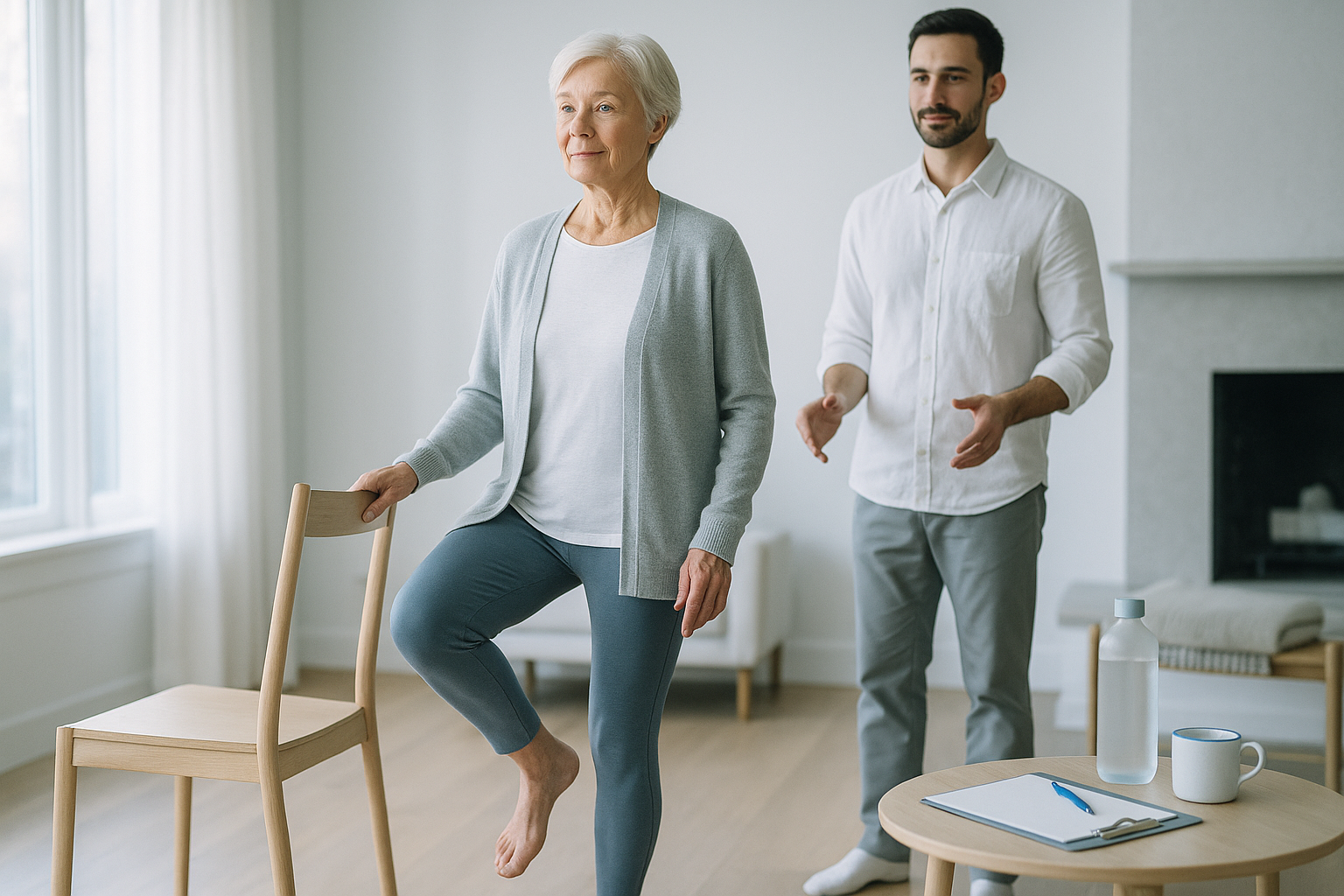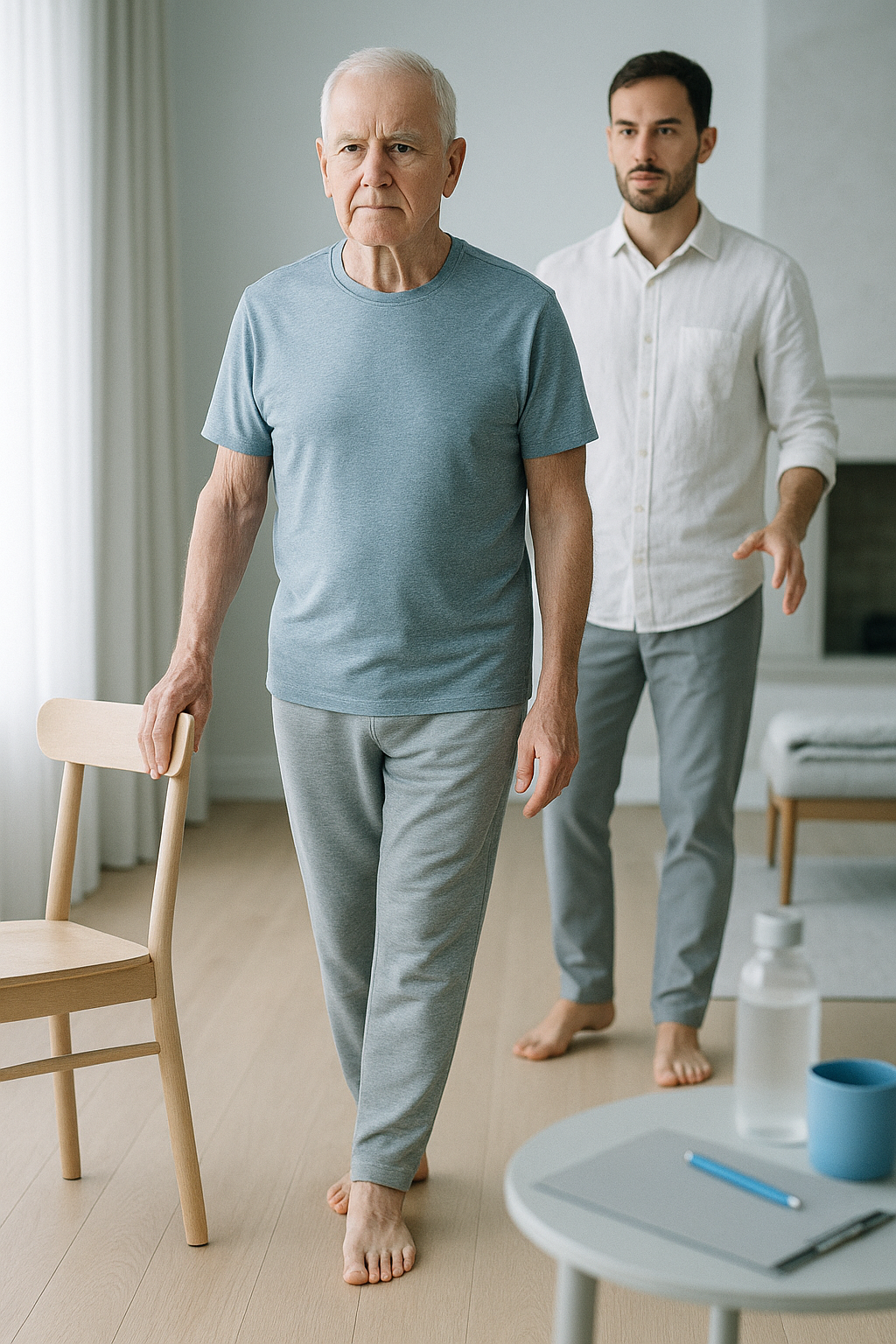
Share
Estimated reading time: 19 minutes
Falls are the leading cause of injury-related hospitalisations among Canadian seniors. Each year, one in three Canadians aged 65 and older experiences at least one fall. These events not only drive emergency department visits and hospital admissions—they also threaten independence, mobility, and quality of life.
Balance exercises to prevent falls offer a proven, accessible way to reduce that risk. Evidence shows that regular balance training, especially when combined with lower-body strength work, can reduce falls by 23–37% and significantly lower the risk of serious injuries such as fractures and head trauma. Best of all, most balance exercises can be practised safely at home with minimal equipment.
This guide provides a clear, progressive routine backed by Canadian and international research. You'll learn how to screen your own fall risk, master beginner through advanced balance moves, pair them with strength training, design a safe home program, and track your progress over time.
Key Takeaways
- Falls affect one in three Canadian seniors each year and are the top cause of injury-related hospital admissions in older adults.
- Balance training—alone or combined with strength exercises—reduces falls by 23–37% and lowers fall-related injuries substantially.
- Simple at-home screening tools like the Timed Up and Go test and single-leg stance help identify elevated fall risk before you start.
- A progressive home routine of 15–20 minutes, at least three times per week, delivers measurable improvements in balance and confidence within 12 weeks.
- Stop immediately if you experience chest pain, dizziness, severe joint pain, or a near-fall, and consult a healthcare provider.
Why Balance Exercises to Prevent Falls Matter
Falls are not a normal part of ageing—they are largely preventable. Balance exercises to prevent falls directly target the postural control deficits that increase fall risk as we age. Regular practice improves your ability to recover from a stumble, navigate uneven surfaces, and carry out daily activities with confidence.
Research consistently shows that balance training reduces the incidence of falls by 23–28%. When combined with functional and strength exercises, programs achieve even greater reductions—up to 37% fewer falls and a 61% reduction in fractures. These improvements translate into fewer emergency visits, shorter hospital stays, and greater independence at home.
Canadian seniors also benefit from national and provincial fall prevention campaigns. Initiatives such as Finding Balance provide education, resources, and referral pathways to local classes and clinical services. Provincial programs—including Ontario's Stay on Your Feet and Alberta Health's Finding Balance Alberta—offer toolkits, screening events, and group exercise classes tailored for older adults. These publicly funded resources make evidence-based fall prevention accessible across the country.
Expected outcomes from consistent balance training include improved postural control, steadier gait, greater confidence during daily tasks, and a meaningful reduction in both falls and fall-related injuries. For many seniors, these changes preserve the ability to age in place and maintain social connections.
How to Screen Your Fall Risk Before Starting Balance Exercises to Prevent Falls
Before beginning any new exercise routine, it's helpful to understand your current fall risk. Simple at-home screening tools can give you a baseline and help you decide whether to seek professional guidance.
Quick At-Home Checks (How to Perform)
Timed Up and Go (TUG) Sit in a standard chair with armrests. On "go," stand up, walk three metres (about ten feet) at your normal pace, turn around, walk back, and sit down. Time the entire sequence with a stopwatch or smartphone timer. A time greater than 12 seconds indicates elevated fall risk and warrants a conversation with your family doctor or physiotherapist.
Single-Leg Stance Stand next to a sturdy counter or chair back. Lightly rest your fingertips on the support. Lift one foot off the ground and hold for up to ten seconds. Note the maximum time you can hold steady on each leg. Inability to balance for five to ten seconds per leg signals increased risk and suggests you should start balance training with extra support.
Sit-to-Stand Test Sit in a standard chair without using your hands for support. Count how many times you can stand up and sit back down in 30 seconds. This test serves as a simple proxy for lower-body strength, which directly supports balance. Fewer than eight repetitions may indicate weakness that contributes to fall risk.
Document your baseline times and repetitions. Repeat these tests every few weeks to track improvement.
When to Consult a Clinician
Seek professional assessment if any of the following apply:
- You scored above the TUG cut-off (greater than 12 seconds) or cannot hold a single-leg stance for at least five seconds.
- You have fallen two or more times in the past 12 months, especially if a fall resulted in injury.
- You experience dizziness, fainting, chest pain, or shortness of breath during light activity.
- You take medications that increase fall risk (sedatives, blood pressure drugs, or multiple prescriptions).
- You have progressive neurological disease, uncontrolled blood pressure, recent major surgery, or significant vision impairment.
- Your home has tripping hazards (loose rugs, poor lighting, clutter) that you cannot easily modify.
Canadian primary care physicians and physiotherapists routinely use the TUG, single-leg stance, and the Berg Balance Scale to assess fall risk. Many provincial senior fitness programs offer free screening events. If your screens are abnormal or you have risk factors, a comprehensive geriatric assessment by a rehab team can identify specific deficits and tailor a safe, supervised program.
Key Balance Exercises to Prevent Falls for Seniors (Beginner to Advanced)
A well-designed balance program includes both static (stationary) and dynamic (moving) tasks. The goal is to challenge your postural control in a controlled, progressive way. Start with supported exercises, reduce the level of support as you improve, and gradually add complexity—such as closing your eyes, turning your head, or performing a cognitive task at the same time.
Multi-component routines that blend static holds, dynamic movement, and task-specific gait practice consistently reduce falls in older adults. Aim to practise at least three times per week.
Beginner Exercises (Safe Starting Moves)
Weight Shifts (Side-to-Side and Front-Back) Stand with your feet hip-width apart, hands resting lightly on a chair back or counter. Slowly shift your weight to the right foot, lifting the left heel slightly off the ground. Hold for two seconds, then shift left. Repeat side-to-side for ten to twenty shifts. Next, shift your weight forward onto your toes, then back onto your heels. Perform one to two sets. This exercise teaches controlled weight transfer, the foundation of good balance.
Marching in Place and Heel-to-Toe (Tandem) Walk with Hand Support Stand beside a counter. March in place, lifting each knee to a comfortable height, for 30–60 seconds. Then practise a heel-to-toe walk: place the heel of one foot directly in front of the toes of the other, as if walking a tightrope. Keep one hand on the counter for support. Take ten to twenty slow, controlled steps. Focus on smooth, steady movement rather than speed.
Supported Single-Leg Stance Stand facing a sturdy counter or chair back. Rest your fingertips lightly on the surface. Lift your right foot a few centimetres off the floor and hold for five to twenty seconds. Lower and repeat on the left leg. Perform three to five holds per leg. As you improve, reduce finger pressure and eventually try letting go for short intervals.
Safety Cues for Beginners Always wear non-slip shoes or go barefoot on a non-slip surface—avoid socks or loose slippers. Clear the exercise area of furniture, cords, and pets. If you are frail or unsteady, have a family member or caregiver nearby during your first few sessions.
Intermediate Exercises (Challenge Stability and Gait)
Tandem Stance with Head Turns (Vestibular Challenge) Stand in a narrow stance—one foot directly in front of the other—with light finger support on a counter. Once stable, slowly turn your head to look left, then right, while maintaining balance. Hold the stance for 20–40 seconds. Perform two to three repetitions. This exercise adds a vestibular (inner ear) challenge that mimics real-world tasks like checking for traffic.
Side-Stepping, Backward Walking, and Obstacle Stepping Side-step along a clear hallway, moving laterally for ten steps in each direction. Next, practise backward walking with one hand trailing a wall for safety—ten steps back, turn, and return. Finally, set a low object (such as a folded towel or small book) on the floor and practise stepping over it forward and sideways. These dynamic drills train reactive balance and prepare you to navigate curbs, thresholds, and uneven terrain.
Mild Dual-Tasking Combine a simple cognitive task with walking or balancing. For example, count backward by threes while walking heel-to-toe, or recite the days of the week while holding a single-leg stance. Dual-tasking improves your ability to balance during conversations or while carrying objects—common real-life scenarios.
Advanced Exercises (For Well-Screened Seniors Under Supervision)
Foam Pad Single-Leg Stands and Controlled Perturbations Once you can hold a single-leg stance on a firm surface for 30–40 seconds, progress to standing on a foam balance pad. The unstable surface forces your ankle and hip muscles to work harder. Perform multiple 20–40 second holds per leg. Some seniors, under the guidance of a physiotherapist, may also practise controlled perturbations—small, unexpected pushes or pulls—to train rapid recovery responses. These drills should only be attempted after professional clearance.
Balance Board or Wobble-Board Progressions Balance boards and wobble discs add rotational instability. Stand on the device with both feet, hands near a support, and try to keep the board level for 20–40 seconds. Progress to single-leg balancing or small squats. These tools are excellent for higher-functioning seniors but require initial supervision to prevent injury.
Cognitive-Motor Dual-Task Drills Simulate real-life complexity by combining navigation with problem-solving. Set up a simple obstacle course (cones, pillows, or pool noodles) and walk through it while answering questions or sorting objects by colour. This type of training has been shown to improve both balance and cognitive function in older adults.
Strength Training Elderly: Lower-Body Moves That Support Balance
Balance and strength are partners in fall prevention. Strong leg muscles support your ability to recover from a stumble, rise from a chair without assistance, and climb stairs safely. Research shows that combining balance training with lower-body strength exercises leads to greater reductions in falls—up to 30%—than either approach alone.
Aim for two to three strength sessions per week, allowing at least one day of rest between sessions. Start with one to three sets of eight to twelve repetitions for each exercise. Increase resistance gradually by slowing the tempo, adding light hand weights, or using a resistance band.
Practical Lower-Body Exercises (How to Prescribe)
Sit-to-Stand Sit in a sturdy chair with your feet flat on the floor, hip-width apart. Lean forward slightly, then push through your heels to stand up fully. Lower yourself back down with control—don't drop into the seat. Perform three sets of eight to twelve repetitions. To progress, slow the lowering phase to a three-second count, or hold a light weight at your chest.
Chair Squats and Partial Squats Stand in front of a chair, feet shoulder-width apart. Lower your hips back and down as if sitting, but stop just before touching the seat. Push through your heels to return to standing. Keep your knees tracking over your toes and your chest lifted. Perform two to three sets of ten to twelve repetitions. This exercise builds quadriceps, glutes, and hip stability—all critical for balance.
Calf Raises Stand with your feet hip-width apart, hands resting on a counter for balance. Rise up onto the balls of your feet, hold for two seconds, then lower slowly. Perform two to three sets of ten to fifteen repetitions. Strong calves support ankle stability and help prevent trips.
Resistance-Band Hip Abduction Loop a resistance band around both ankles. Stand with feet together, hands on a counter. Keeping your knee straight, lift your right leg out to the side against the band's resistance. Hold for one second, then lower with control. Perform ten to fifteen repetitions per leg for two to three sets. This exercise strengthens the hip abductors, which stabilise your pelvis during walking and standing.
Safety and Adaptations If you experience joint pain, reduce the range of motion or the number of repetitions. Use a chair for support during squats and lunges. Resistance bands are inexpensive, portable, and easy to adjust. Stop immediately if you feel dizzy, short of breath, or experience sharp pain.
Designing a Safe Home Routine for Balance Exercises to Prevent Falls
A structured routine makes it easier to stay consistent and see results. Aim for 15–20 minutes per session, at least three times per week. Include both balance and strength exercises in each session, or alternate them on different days.
Sample Session Structure
- Warm-up (3–5 minutes): March in place, perform ankle circles, and do gentle shoulder rolls to prepare your muscles and joints.
- Balance work (5–7 minutes): Choose two to three exercises from the beginner or intermediate lists. Perform one to two sets of each, with brief rests between.
- Strength work (5–7 minutes): Perform one to two lower-body exercises (sit-to-stand, calf raises, or resistance-band work) for two to three sets.
- Cool-down (2–3 minutes): Gentle stretching of the calves, hamstrings, and hip flexors.
Sets and Repetitions Guidance Begin with one to two sets of eight to twelve repetitions for strength moves, or time-based holds (20–40 seconds) for balance drills. Gradually increase to three sets or longer holds as your tolerance improves.
Environmental Safety Exercise in a well-lit, clutter-free space. Use a non-slip mat on hard floors. Keep a sturdy chair or countertop within arm's reach at all times. Remove loose rugs, cords, and pets from the area. Wear supportive, non-slip footwear or go barefoot on a safe surface—avoid socks on hardwood or tile.
Equipment and Low-Cost Aids Most balance exercises require nothing more than a chair and clear space. A set of resistance bands costs less than twenty dollars and adds variety to your strength work. Non-slip mats are available at pharmacy and sporting-goods stores. For social support and professional guidance, consider joining a supervised group class at a local community centre or enrolling in a virtual program offered by provincial health agencies.
Safety Device Recommendation If you exercise alone and have elevated fall risk, consider using a medical alert or fall-detection service during your sessions. Devices such as Holo Alert can automatically notify emergency contacts or responders if a fall is detected, providing an extra layer of safety while you build strength and balance at home.
Safety Tips, Common Modifications, and When to Stop an Exercise
Balance training is generally safe for older adults, but you should always listen to your body and modify exercises as needed.
Immediate Stop Signs Stop exercising immediately and seek medical attention if you experience:
- Chest pain, pressure, or tightness
- Severe dizziness, fainting, or feeling lightheaded
- Sudden, sharp joint pain
- Shortness of breath that doesn't resolve with rest
- A near-fall or actual fall
If symptoms are severe or persist, call 911 or visit your nearest emergency department.
Common, Low-Risk Modifications Many exercises can be adapted to match your current ability:
- Use two hands on a support instead of one, or keep both hands on a chair throughout the exercise.
- Reduce the range of motion—for example, perform a quarter squat instead of a full squat.
- Shorten the duration of holds or reduce the number of repetitions.
- Perform exercises while seated (such as seated marching or seated leg lifts) if standing feels unsafe.
Mild muscle soreness the day after exercise is common and usually resolves within 48 hours. Persistent or worsening joint pain, swelling, or stiffness warrants a consultation with your doctor or physiotherapist.
When Supervised Programs Are Indicated Seek professional guidance if you:
- Have a history of recurrent falls (two or more in the past year)
- Experience progressive instability or neurological symptoms
- Have significant cognitive impairment or memory loss
- Are recovering from major surgery (hip replacement, spinal surgery, cardiac procedures)
- Use a walker or cane and are unsure how to incorporate it safely during exercises
Canadian public health programs offer supervised group classes, virtual check-ins with kinesiologists, and tele-rehabilitation services. Many provincial health authorities provide free or low-cost access to these resources for seniors.
Role of Assistive Devices If you use a cane or walker, do not abandon it during balance training without professional guidance. A physiotherapist can teach you when and how to reduce reliance on assistive devices safely as your strength and balance improve.
Tracking Progress and Staying Consistent with Balance Exercises to Prevent Falls
Consistency is the key to long-term success. Tracking your performance helps you see improvement, stay motivated, and identify when it's time to progress to harder exercises.
Simple Metrics to Log
- Maximum single-leg stance time (per leg)
- Timed Up and Go test time
- Number of tandem (heel-to-toe) steps without loss of balance
- Sit-to-stand repetitions in 30 seconds
- Resistance-band colour or tension level for strength exercises
Record your baseline measurements and retest every two to four weeks. Even small gains—an extra two seconds of balance or one more repetition—are meaningful.
Sample 12-Week Progression Template
- Weeks 1–4 (Build Tolerance): Perform beginner exercises with full support. Focus on proper form and consistency. Aim for three sessions per week.
- Weeks 5–8 (Increase Challenge): Reduce hand support—use fingertip contact or let go for short intervals. Add intermediate exercises such as tandem stance with head turns.
- Weeks 9–12 (Add Complexity): Progress to eyes-closed variations, dynamic drills (side-stepping, backward walking), and mild dual-tasking. Consider foam-pad or balance-board work if you have professional supervision.
Behavioural Tips for Adherence Link your exercise routine to an existing daily habit. For example, practise single-leg balance while brushing your teeth, or do sit-to-stands during commercial breaks. Exercise with a friend or family member—social support significantly improves adherence. Join a community class or virtual group for accountability and encouragement.
Many seniors find printable logs helpful. Local health units and organisations such as Active Aging Canada offer free tracking sheets and fall prevention calendars. Fitness trackers and smartphone apps can also send reminders and log your activity automatically.
Technology Aids Wearable devices—including smartwatches and fall-detection pendants—can monitor your activity and alert caregivers or emergency contacts if a fall is detected. Holo Alert and similar services integrate fall detection with medical alert capabilities, providing peace of mind during unsupervised exercise sessions. Ensure any device you choose is compatible with your smartphone and respects your privacy preferences.
Frequently Asked Questions
What are the best balance exercises to prevent falls for seniors? A mixed program that includes weight shifts, supported single-leg stance, heel-to-toe (tandem) walking, and functional strength exercises such as sit-to-stand delivers the best results. Start with exercises that allow you to use support, and progress to more challenging variations as your balance improves.
How often should seniors do balance exercises to prevent falls? Aim for balance practice at least three times per week, plus lower-body strength training two to three times per week. Short, daily practice sessions—even five to ten minutes—improve retention and confidence more effectively than infrequent, longer sessions.
Can strength training elderly actually reduce fall risk? Yes. Research shows that combining balance exercises with lower-body strength training produces greater reductions in falls than either approach alone. Strong leg muscles help you recover from trips and maintain stability during everyday activities.
Are fall prevention exercises safe to do at home without a therapist? Many balance and strength exercises are safe for home practice if your screening results are normal, your environment is hazard-free, and you have access to stable support. Seniors with abnormal screening results, a history of multiple falls, or medical conditions that increase fall risk should seek initial professional clearance. Using a medical alert service during unsupervised sessions adds an extra layer of safety.
How long until I see improvement from balance exercises to prevent falls? Most people notice measurable improvements in balance, strength, and confidence within six to twelve weeks of regular, progressive practice. Reduction in actual fall rates typically requires sustained participation over several months, as demonstrated in controlled research programs.
Wrapping Up
Balance exercises to prevent falls are one of the most effective, accessible interventions available to Canadian seniors. The evidence is clear: regular practice reduces falls by 23–37%, lowers the risk of serious injuries, and helps preserve independence and quality of life.
Start by screening your fall risk with simple at-home tests such as the Timed Up and Go and single-leg stance. Choose beginner exercises that match your current ability—weight shifts, marching in place, and supported single-leg holds are safe, effective starting points. Pair balance drills with lower-body strength work (sit-to-stand, calf raises, resistance-band exercises) two to three times per week.
Progress gradually by reducing hand support, adding dynamic movement, and introducing mild dual-tasking. Track your performance every few weeks to stay motivated and identify when to advance. Ensure your exercise space is well-lit, clutter-free, and equipped with stable support within arm's reach.
Stop immediately if you experience chest pain, severe dizziness, or a near-fall, and consult a healthcare provider. Modify exercises as needed—use more support, reduce range of motion, or perform seated versions if standing feels unsafe. If you have a history of recurrent falls, neurological symptoms, or other risk factors, seek guidance from a family physician or physiotherapist before beginning a new program.
Consistency is the key to long-term success. Build balance practice into your daily routine, exercise with a friend, or join a community class for social support. Consider using a medical alert service such as Holo Alert for added safety during solo sessions.
With patience, practice, and the right precautions, balance exercises can help you move with confidence, reduce your fall risk, and continue enjoying the activities and independence that matter most.
Find Your Perfect Medical Alert
Answer a few quick questions to discover which Holo Alert system is best for you or your loved one.















